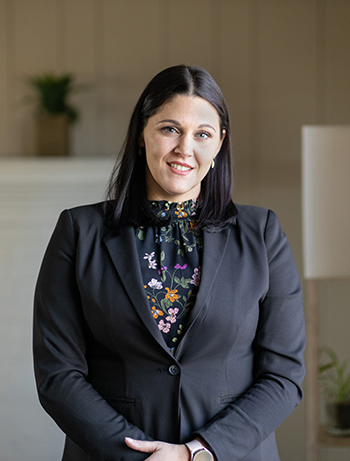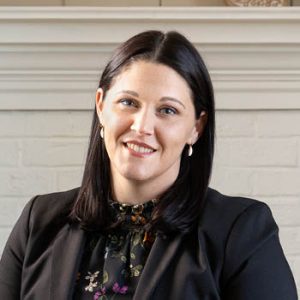Guiding clients in a ‘plan first, invest second’ philosophy
Guiding clients in a ‘plan first, invest second’ philosophy


Shannon LaRosse • Reading, PA
Informed Family Services • USA Financial Securities Corp.
Read full biography below
 I initially pursued a career in professional counseling, which had been an area of emphasis in my college studies. As I looked for an appropriate position, I took a temp job with a law firm. As it turns out, I enjoyed that environment. While working there, I took paralegal and accounting courses. After some time at the firm, I assumed paralegal responsibilities and worked on budget and finance issues. Unfortunately, the firm had some organizational issues. I knew it was time to move on and considered my options. I knew what I wanted to do next—work in the financial field, in a position directly tied to financial planning and money management.
I initially pursued a career in professional counseling, which had been an area of emphasis in my college studies. As I looked for an appropriate position, I took a temp job with a law firm. As it turns out, I enjoyed that environment. While working there, I took paralegal and accounting courses. After some time at the firm, I assumed paralegal responsibilities and worked on budget and finance issues. Unfortunately, the firm had some organizational issues. I knew it was time to move on and considered my options. I knew what I wanted to do next—work in the financial field, in a position directly tied to financial planning and money management.
I feel fortunate to have obtained a position in 2013 with Strategic Wealth Advisory, starting as a financial assistant. The founder of that firm, Earl Schultz, is a highly experienced financial advisor. He is a great educator with clients and staff, and I could not have found a better mentor. I learned the advisory business from the ground up, gradually taking on more responsibility until I reached the point of serving my own client base. Earl is always available as a sounding board, and we collaborate frequently.
I strongly emphasize my professional development, continuing education in the industry, and my role as a fiduciary—putting clients’ interests ahead of all else. Over the past eight years, I have grown tremendously as a financial advisor. I take great pride in guiding clients through comprehensive retirement planning that encompasses income distribution, asset growth, and tax planning.
We consider ourselves distribution-phase advisors. Our target audience is basically individuals or couples around age 55 and up—those considering transitioning into retirement in the next several years or those who are recently retired—especially people who feel they haven’t properly addressed retirement planning. While our clients are diverse, the common denominator they have is a strong interest in making the most of what they have, and a willingness to partner with us in developing a sound retirement plan. While we don’t target them specifically, we have a good percentage of engineers and teachers. I attribute this to a mindset that tends to appreciate our comprehensive approach to planning.
The process begins with getting to know a client on a personal level. My educational background in counseling has been very helpful—the whole discipline of active listening and facilitating a conversation. However, both Earl and I are also naturally drawn to meeting new people and enjoy hearing about their lives, families, interests, and aspirations for the future. In addition to helping people plan for their financial goals, we want to help put them in a better position to pursue their life goals.
The next step is financial discovery. We ask all clients to fill out a profile questionnaire and provide key financial documents. We prefer this to be an interactive process rather than having a new client just compile their data and “send it in.” As we delve more deeply with them into their finances, how they’re currently set up, and their feelings about investing, it opens up more questions. It frequently identifies areas where they hadn’t considered how things could be different and much more efficient. Throughout our discussions, we are gathering insights that will inform the setting of retirement goals.
At this point, we use an interactive illustration drawn on a whiteboard that uses the analogy of mountain climbing. We ask, “What’s the most dangerous part of a mountain climb? Going up or coming down the mountain?” We’ll say that the most dangerous part is actually coming down the mountain. Novice climbers spend their time focusing on the goal of reaching the top, but coming back down is usually an afterthought. They’re unprepared for the unique challenges they might experience on that descent.
The analogy carries over to the difference between the accumulation phase of a client’s financial life and the distribution or income-planning phase. It comes down to understanding the differences between a working lifetime of asset accumulation and a retirement need for asset designation to help meet future goals and create income.
We review what we call the seven unique challenges for retirement planning or “coming down the mountain.” These include the areas of Social Security claiming strategies, how to efficiently create a retirement “paycheck,” the potential impact of sequence-of-returns risk in retirement, inflation uncertainty, the need to manage investment risk, and viewing all retirement-planning strategies through the lens of tax efficiency. The last or seventh area is what we call “Life’s What Ifs.” Here we discuss a number of life events that could derail a retirement plan if they are not properly planned for.
Next, we set goals that will shape our firm’s recommended plan. If the situation calls for it, we might involve one of our professional resources, such as an estate attorney, in the planning process. The result is a plan that includes how a client can create a suitable level of income in retirement based on their available resources, as well as how to effectively take required minimum distributions. It will assign a “job description” to each investment asset and how and when each will be used in the process of creating income. We then thoroughly review our recommendations with clients, make any adjustments that might be required, and move forward with plan implementation and ongoing monitoring and review.

As we go through the seven challenges, we hone in on the need for active risk management. While risk management can be beneficial to an accumulation plan, it becomes essential in retirement distribution planning. It ties back into the sequence-of-returns risk—and knowing that a client will be able to pull their income, regardless of how the stock market performs.
As we develop the distribution plan, we don’t identify specific investment vehicles at that stage. But we do identify the types of purpose-driven accounts that need to be actively risk managed. In general, we are examining the three broad categories of short-to-medium-term-income accounts, growth accounts, or vehicles that provide a lifelong income benefit.
We use the services of third-party investment managers for active, risk-managed strategies. These managers have been carefully vetted and have robust strategy, research, and management teams. Their sole responsibility is the daily management of their firm’s investment strategies. We carefully examine their performance in different types of market environments. We look to see if they can produce competitive returns in positive markets and—importantly—strive to mitigate losses in poor market conditions.
We believe in approaches that take advantage of market trends, not “market timing.” And, even in volatile markets, we believe our managers can find growth opportunities. From the point of view of a client’s long-term portfolio growth, we believe it is not always about trying to outperform an index. It is also about mitigating losses. Many people erroneously think that taking on more risk will lead to higher returns. Occasionally, that is true. But for less volatile, long-term portfolio growth, we think actively risk-managed strategies can play an important role.
Our investment managers can provide risk-managed strategies that should be suitable for any of our clients, from those with conservative risk profiles to clients who want a fairly aggressive approach. Another benefit is that several of the active strategies we use can go inverse the market, use leverage, actively rotate to stronger-performing sectors, or simply reduce or increase market exposure—if the market situation is appropriate for any of those approaches. Those are things that a passive, buy-and-hold strategy will just not offer.
I think at the top of the list is being trustworthy—always striving to act in the best interests of our clients. We also take great pride in the comprehensive and customized nature of our planning and investment process. We tell clients, “Plan first and invest second.” That plays out in having a truly goals-based investment approach. And, finally, we want to always be there as a resource for anything related to our clients’ financial lives. We want to make working with our firm as much of a turnkey process as possible, building strong, enduring relationships that clients will value highly.
 Shannon LaRosse is an investment advisor representative at Informed Family Financial Services, which has multiple offices in eastern Pennsylvania. Ms. LaRosse says, “I am passionate about helping people work toward their financial goals. … They deserve to retire well and with a solid financial plan in place.”
Shannon LaRosse is an investment advisor representative at Informed Family Financial Services, which has multiple offices in eastern Pennsylvania. Ms. LaRosse says, “I am passionate about helping people work toward their financial goals. … They deserve to retire well and with a solid financial plan in place.”
Ms. LaRosse was raised in Pottstown, Pennsylvania. She says she and her four siblings grew up in a highly supportive and faith-based family environment. She attended both public and private schools and was homeschooled during her high school years. Growing up, she enjoyed sports, going on field trips and vacations with her family, and actively participating in her church’s youth group—especially missionary projects.
Ms. LaRosse attended Lancaster Bible College and graduated with a Bachelor of Science degree in biblical science, with an emphasis in professional counseling. She also studied abroad at the Word of Life Bible Institute Hungary. She has earned a Certificate of Proficiency in accounting.
Ms. LaRosse started her business career as an office manager and paralegal at a law firm. In 2013, she joined Strategic Wealth Advisory, which was acquired by Informed Family Financial Services in 2022. She guides clients in comprehensive retirement planning. She says she emphasizes her professional development, continuing education in the industry, and role as a fiduciary who “places clients’ interests ahead of all else.”
Ms. LaRosse and her husband have two young daughters. They enjoy spending family time together, along with their three dogs. Ms. LaRosse also enjoys family hikes, gardening, biking, and competing in organized running events.
Disclosure: Shannon LaRosse is an investment adviser representative of, and securities and advisory services are offered through, USA Financial Securities Corp. (Member FINRA/SIPC.) USA Financial Securities is a registered investment adviser located at 6020 E. Fulton St., Ada, MI 49301. Informed Family Financial Services Inc. is not affiliated with USA Financial Securities.
Photography by Michael Branscom
New this week:

Explaining the seven challenges for retirement planning
Shannon LaRosse is an investment advisor representative and financial advisor at Informed Family Financial Services, which has multiple offices in eastern Pennsylvania. She says, “We consider ourselves distribution-phase advisors. Our target audience is basically individuals or couples around age 55 and up—those who are considering transitioning into retirement in the next several years.”
As part of her firm’s educational discussions with new clients, Ms. LaRosse reviews seven unique challenges of retirement planning:
- Determining a suitable Social Security strategy—how and when benefits should be claimed.
- How to efficiently create a reliable retirement “paycheck.”
- The potential impact of sequence-of-returns risk in retirement.
- Building a retirement plan that can adapt to periods of rising inflation.
- The need for investment-risk management during the retirement distribution phase.
- Creating tax efficiency in deploying assets for retirement income.
- Preparation for life’s “What Ifs?”—events that can damage a well-funded but underplanned retirement.

